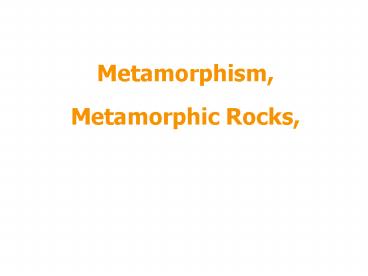Powerpoint Presentation Physical Geology, 10e - PowerPoint PPT Presentation
1 / 19
Title:
Powerpoint Presentation Physical Geology, 10e
Description:
Occurs in narrow zone (~1-100 m wide) known as contact aureole ... The size and shape of an aureole is controlled by: The nature of the pluton ... – PowerPoint PPT presentation
Number of Views:34
Avg rating:3.0/5.0
Title: Powerpoint Presentation Physical Geology, 10e
1
Metamorphism, Metamorphic Rocks,
2
Metamorphic Rocks
- Metamorphism refers to solid-state changes to
rocks in Earths interior - Produced by increased heat, pressure, or the
action of hot, reactive fluids - Old minerals, unstable under new conditions,
recrystallize into stable ones - Rocks produced from pre-existing or parent rocks
in this way are called metamorphic rocks - Metamorphic rocks common in the old, stable cores
of continents, known as cratons
3
Factors Controlling Metamorphic Rock
Characteristics
- Texture and mineral content of metamorphic rocks
depend on - Parent rock composition
- Temperature and pressure during metamorphism
- Effects of tectonic forces
- Effects of fluids, such as water
- Parent rock composition
- Usually no new elements (other than water) are
added to rocks during metamorphism - Resulting metamorphic rock must have very similar
elemental composition to that of parent rock
4
Factors Controlling Metamorphic Rock
Characteristics
- Temperature during metamorphism
- Heat for metamorphism comes primarily from
outward flow from Earths deep interior - All minerals stable over finite temperature range
- If range exceeded, new mineral structures result
- If temperature gets high enough, melting will
occur - Pressure during metamorphism
- Confining pressure is pressure applied equally in
all directions - Pressure generally proportional to depth of
burial within the Earth - Metamorphic pressure typically increases 1
kilobar per 3.3 km of burial within the crust - High-pressure minerals have more compact
structure/higher density
5
Factors Controlling Metamorphism
- Tectonic forces
- Often lead to forces that are not equal in all
directions (differential stress) - Compressive stress causes flattening
perpendicular to stress - Shearing causes flattening by sliding parallel to
stress - Planar rock texture of aligned minerals produced
by differential stress is known as foliation - Foliation increases with pressure and time
6
Factors Controlling Metamorphism
- Fluids
- Hot water (as vapor) is most important
- Rising temperature causes water to be released
from unstable minerals - Hot water very reactive acts as rapid transport
agent for mobile ions - Time
- Metamorphism, particularly from high pressures,
may take millions of years - Longer times allow newly stable minerals to grow
larger and increase foliation
7
Metamorphic Rock Classification
- Classification based on rock texture
- Foliated (layered) vs. non-foliated (non-layered)
- Foliated rocks named based on type of foliation
(slaty, schistose, gneissic) - Non-foliated rocks named based on composition
8
Types of Metamorphism
- Contact metamorphism
- High temperature is dominant factor
- Produces non-foliated rocks
- Occurs adjacent to magma bodies intruding cooler
country rock - Occurs in narrow zone (1-100 m wide) known as
contact aureole - Rocks may be fine- (e.g., hornfels) or
coarse-grained (e.g., marble, quartzite)
9
(No Transcript)
10
The Types of Metamorphism
Contact Metamorphism The size and shape of an
aureole is controlled by
- The nature of the pluton
- Size
- Shape
- Orientation
- Temperature
- Composition
- The nature of the country rocks
- Composition
- Depth and metamorphic grade prior to intrusion
- Permeability
11
Types of Metamorphism
- Regional metamorphism
- High pressure is dominant factor
- Results in rocks with foliated textures
- Prevalent in intensely deformed mountain ranges
- Higher pressure and temperature will produce
increased metamorphic grade - metamorphism of shale produces
- slate
- phyllite
- schist
- gneiss
12
(No Transcript)
13
(No Transcript)
14
Figure 21-8. Regional metamorphic map of the
Scottish Highlands, showing the zones of minerals
that develop with increasing metamorphic grade.
From Gillen (1982) Metamorphic Geology. An
Introduction to Tectonic and Metamorphic
Processes. George Allen Unwin. London.
15
A. Foliated
16
(No Transcript)
17
(No Transcript)
18
Index minerals
19
Plate Tectonics and Metamorphism
- Regional metamorphism associated with destructive
plate boundaries - Pressure generally proportional to depth
- Temperature at given depth varies laterally
- Isotherms (lines connecting points with equal
temperatures) bow down sharply within cool
sinking oceanic plate and bow up where magma
rises beneath continental plate































